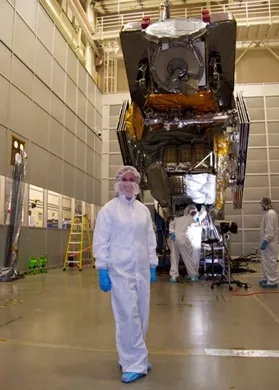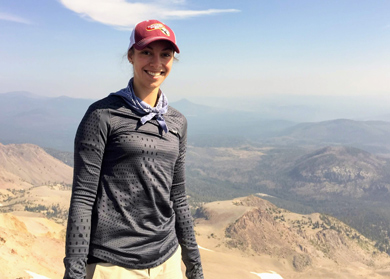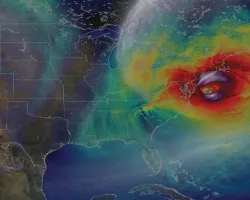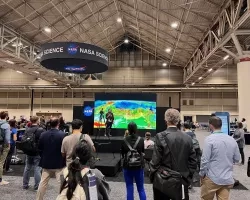This March, NASA pays tribute to the many women who have played an essential role in shaping the history of the Agency. From astronauts to specialists in the fields of science, technology, engineering, and mathematics (STEM), as well as professionals in communications, human resources, and more, women are helping NASA fulfill its mission to explore our universe – and understand our home planet – for the benefit of all. In honor of Women’s History Month, we celebrate some of the women in the Earth Science Applied Sciences Disasters program area and the significant contributions they make.
Since NASA formed the Disasters program area in 2002, it has flourished under the guidance of a dedicated team of researchers, response coordinators, science communicators, and leaders. “Science and gender equality are often at odds with one another, and women scientists are still heavily underrepresented in fields pertaining to science and technology, says Dr. Shanna McClain, Disasters program manager. “We are working diligently to create a cultural shift across NASA and within the Disasters Program to not only celebrate diversity in all its forms but to change the perspectives of who and what a scientist can be for future generations.”
Changing our Understanding of Landslide Risk
Dalia Kirschbaum is the Chief of the Hydrological Sciences Laboratory at NASA’s Goddard Space Flight Center, where she focuses on regional and global landslide hazard modeling. She is also the principal investigator for a project that uses satellite data to study where and when landslides may be happening around the world. Kirschbaum and her team’s work is pioneering in landslide research, as it provides the only open-source, continually updating model of rainfall-triggered landslide hazards that is available in near real-time across most of the world. Learn more about Kirschbaum’s work here.
Improving Global Flood Response
Margaret “Maggi” Glasscoe is a geophysicist at NASA’s Jet Propulsion Laboratory. Glasscoe is the principal investigator for a project that assesses floods on a global scale and creates risk alerts. The goal of her project is to create a unified global risk assessment and alerting system that will feed into the Pacific Disaster Center’s DisasterAWARE platform – software that serves as a global platform for end-users to make informed disaster response decisions. Learn more about Glasscoe’s work here.
Together, Glasscoe and Kirschbaum harness their data to improve landslide and flood alerting with the Pacific Disaster Center. Learn more about their collaborative work here: Maggi Glasscoe and Dalia Kirschbaum: Collaborating to Improve Flood and Landslide Monitoring.
Reducing the Risk of Communities Living Near Volcanoes
Elodie Macorps joined the NASA Disasters program in 2019 as a student researcher, working to apply satellite data to volcanic eruptions to help lower risk for communities that live near active volcanoes. In February of 2021, she successfully defended her Ph.D. thesis, earning the well-deserved title of “Dr. Macorps.” Learn more about Macorps here: Saving Lives and Knowing Your Worth with Elodie Macorps.
Visualizing Disasters Through a New Lens
Shayna Skolnik is the founder and CEO of Navteca, a woman and minority-owned technology company that focuses on emerging technologies and IT innovations through artificial intelligence, cloud solutions and advanced data visualization. Through Navteca, Skolnik collaborates with NASA to investigate the potential of virtual reality in disaster management. Learn more about Skolnik here: Shayna Skolnik: Visualizing Disaster Impacts with Virtual Reality.
Translating Satellite Data for Decision-Makers
Lori Schultz is a center coordinator for the NASA Applied Sciences Disasters program area. Schultz is also a member of a floods research team that uses remote sensing to create flood products. The research team has supported flood events such as those in the Midwest in 2019, Australia in 2021, the Pacific Northwest in 2021, and hurricanes such as Eta and Iota in 2020. Learn more about Schultz here: Piecing Together Earth Data with Lori Schultz.
Coordinating Disaster Response and Recovery
Jennifer Paris is a Disaster management coordinator based at NASA Headquarters in Washington, D.C. She helps maintain situational awareness of global disaster activations, supports program personnel for successful response and collaboration, coordinates with partner agencies and organizations, and helps document and track events and communication with stakeholders. Paris was the youngest and first female Emergency Response Manager within Florida’s Bureau of Emergency Response and the first female in the Bureau to become a State Certified Hazardous Materials Technician. Learn more about Paris here: From Ocean Conservation to Disaster Response with Jennifer Paris
The NASA Disasters program area is committed to promoting gender equality in both science and the workplace. As we applaud the contributions of women who have made their mark in history, we also honor the contributions women are making toward disaster research, innovation, and application today. We are proud to honor their contributions toward understanding and sharing the science to create a more informed and disaster-resilient world.









